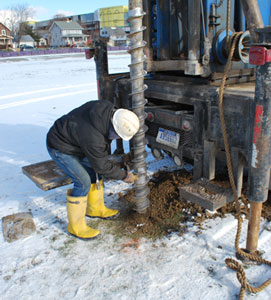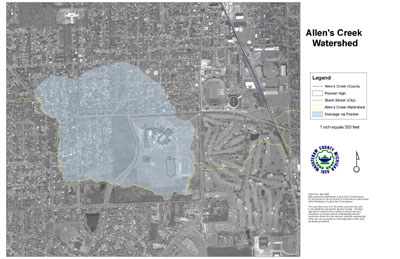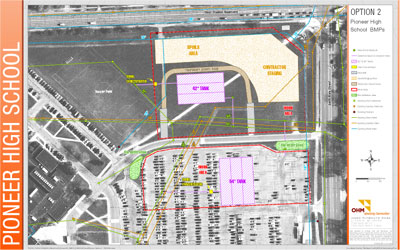Drilling for the Drains

Pat Cody looks a bit cold working on the drilling rig in the Pioneer High School field diagonally across from Michigan Stadium.
When Steve Bean filed a Stopped. Watched. item reporting a drilling rig putting holes in the Pioneer High School lawn, The Chronicle sprang into action. We figured we already knew what it was about: a project to improve the water quality of the Allen Creek watershed, which the Ann Arbor city council had approved at its Nov. 17 meeting. Just the same, the possibility of a giant drill in action is hard to resist.
Bean’s description was dead-on. When The Chronicle arrived on the scene, Pat Cody was leading a three-man crew drilling a total of eight holes to a depth of 40 feet. They were working on the fifth one. The point of these bores was to find out exactly what was down there in order to make decisions about optimal placement of the giant tanks that will eventually be buried underground at the site.
When The Chronicle made phone contact with Harry Sheehan, environmental manager with the Washtenaw County Drain Commissioner’s office, we reported to him that during the brief time we watched the drilling in action, it seemed like Cody’s team was coming up with sand, sand, sand. Sheehan said that was good news, because some previous test bores under the Pioneer parking lot had found clay, clay, clay.
Sheehan also gave us some additional detail on the Pioneer project, which he’d presented to the Ann Arbor Public Schools Board of Education at their regular meeting just two days prior on Dec. 3.
Why was sand good news? It has everything to do with what the tanks are for. Storm water that is currently carried via 42-inch and 54-inch underground pipes to Allen Creek (which is also an underground pipe, despite the nomenclature) will be diverted to holding tanks to be installed at the Pioneer location. And if the tanks can be located over a sand seam, the water diverted to the tanks for treatment can be allowed to infiltrate through the existing sand substrate – allowing nature’s own filters to do their work – with no additional engineering of the soil required.
Treatment? What sort of treatment does the storm water need? The Huron River has too much phosphorus, and the project at Pioneer is part of an attempt to respond to a mandate from the state to reduce phosphorus loading in the Huron River by 50%. Part of the strategy is to remove phosphorus from the Allen Creek watershed, which feeds the Huron.
The phosphorus to be removed is in solid suspended form, and the amount of phosphorus correlates highly with the amount of total suspended solids (TSS). So the actual treatment process doesn’t target phosphorus per se, but rather all suspended solids. It’s a purely mechanical process that uses swirl concentrators, as opposed to a chemical reaction. When the water is spun, the suspended solids concentrate in the center of the swirl. When velocity is reduced to zero, additional settling out of solids occurs. All this solid matter will need to be sucked out periodically with a vacuum. The swirl concentrators will be located out of view, under the surface in a manhole.
Where the manholes and the tanks will be located has not yet been determined, but Sheehan presented two detailed options to the school board last Wednesday. Option 1 would put two tanks – one connected to the 42-inch pipe and the second connected to the 54-inch pipe – in the grassy field in the northeast corner of the Pioneer property, just southwest of Michigan Stadium. Option 2 would also include two tanks, one for each pipe, but would put the tank for the 54-inch pipe under the paved parking lot just to the south of the grassy field.

The sections of the bore that emerged while The Chronicle was watching were filled with sand, which was good news to Harry Sheehan.
Location is not the only difference between the two options. Because of the added cost involved in dealing with the unfavorable soil conditions under the parking lot, the 54-inch pipe on Option 2 would divert to a tank about half as big as on Option 1. Tank sizes for the 54-inch pipe on the two different options would be 196,000 cft on Option 1 versus 100,000 cft on Option 2. In terms of gallons, that’s around 1.4 million versus 0.7 million gallons.
Another difference between the two options is the possible construction schedule. On Option 1, the main constraint is the UM football season – the grassy area is used for RV parking and tailgating. So construction could begin after the last football game of the season in November 2009. For Option 2, construction on the parking area location could proceed only during summer months when school is not in session. Key dates coming up for the project:
- Jan. 20, 2009: Prepare draft plans and specifications in partnership with AAPS for review by the Michigan Department of Environmental Quality (MDEQ)
- March 27, 2009: Continue to work with AAPS to revise plans for final approval by MDEQ
- June 22, 2009: Loan closing ($4.4 million)
Additional Documentation

Light blue area is the portion of the Allen Creek watershed drained through the Pioneer High School location. It represents around 10% of the total watershed area. Click on the image for a much higher resolution file.







Dave,
This gives pictorial representation of the expression “colder than a well digger’s belt buckle!”
Hey! Is there any chance of using video clips in some of these segments?
Stew
Great coverage and great work explaining the engineering behind the particulate treatment process !